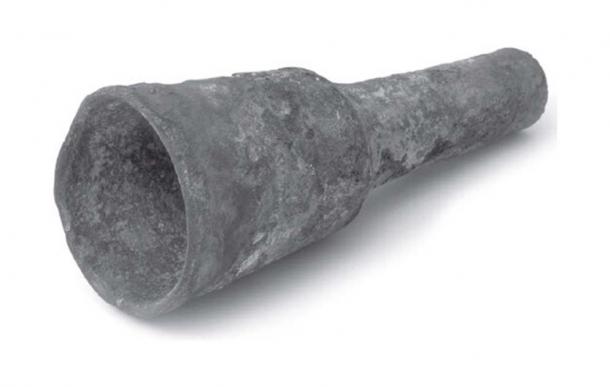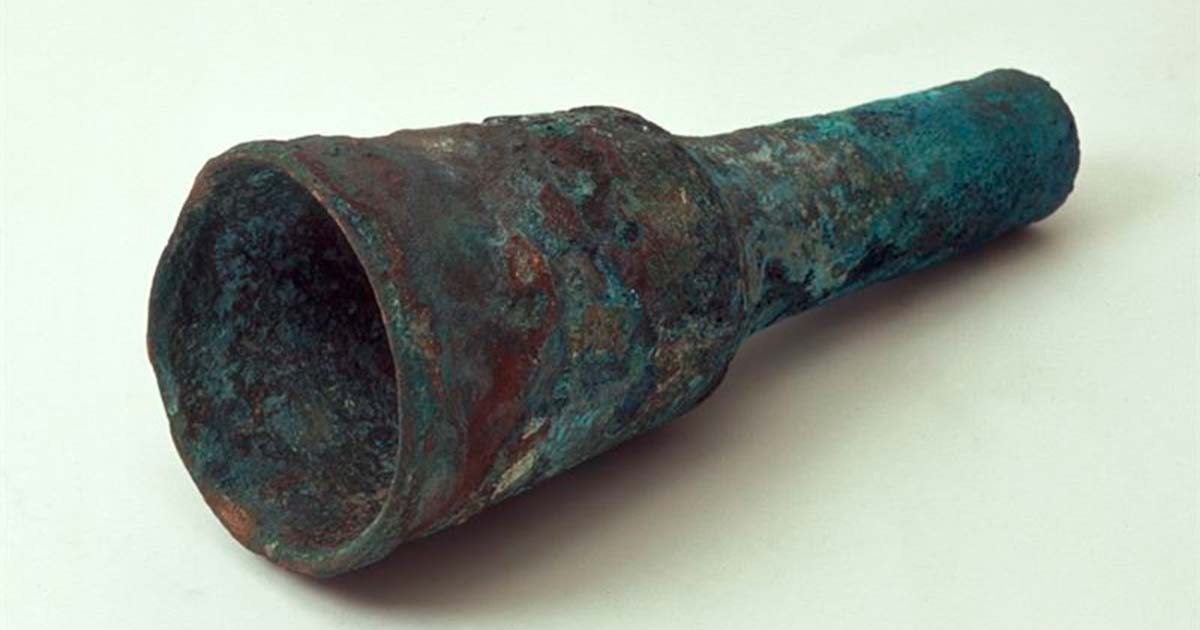Europe’s Oldest Artillery Cannon Found Off the Coast of Sweden
A shipboard cannon, found off the west coast of Sweden, may be the oldest piece of artillery ever found in Europe! Discovered in the waters off Marstrand, the cannon has been crafted from cast copper-alloy and of small, muzzle-loading design. It was discovered by a recreational diver at a depth of 20 meters (65.6 ft) in the Marstrand Sea. A research and study conducted on this oldest cannon has determined it to be a shipboard cannon from a shipwreck, rather than cargo, from the 14th century.
Europe’s Oldest Cannon Locked and Loaded: Fiery Findings of the Study
Remnants of a charge within its powder chamber point to the cannon being fully loaded and prepared for combat when it came to rest on the seafloor. This, and other conclusions have been published in an interdisciplinary study in the journal The Mariner’s Mirror.

In Figure 5, a photograph displays the barrel's bore, revealing what is believed to be remnants of a cartouche positioned at the entrance of the powder chamber. The diameter of the mouth measures 4.5 cm. (Staffan von Arbin/The Mariner’s Mirror)
The outcomes of this interdisciplinary study advance our understanding of the early evolution of artillery on land and at sea. It also serves as a testament to a troubling period faced by both seafarers and coastal communities.
"Thanks to the preserved remains of the charge, it has been possible to use radiocarbon dating to establish the age of the find," says Staffan von Arbin, maritime archaeologist at the University of Gothenburg. “The study’s findings show that the Marstrand cannon is probably from the 14th century, making it one of the oldest artillery pieces ever found in Europe,” he said, quoted in a press release by the university.
- Queen Christina of Sweden Kept an Itty-Bitty Flea Cannon by Her Bed
- Orban’s Colossal Cannon: Holding a Tiger by the Tail – Part II
Substandard Metallurgy Used
The researchers employed advanced 3D scanning techniques and performed a comprehensive chemical analysis of the cannon's metal composition. Their analysis revealed that the cannon was cast from a copper alloy containing approximately 14% lead and only trace amounts of tin.
Interestingly, the composition of this alloy, as noted by the researchers, falls short of being ideal for casting cannons. It is highly probable that if the cannon had been subjected to intensive and prolonged usage, it would have developed cracks and become inoperative.

Side (A), top (B), front (C) and rear (D) view of the Marstrand cannon, based on 3D data collected using a portable laser scanner (Staffan von Arbin)
"Clearly, the person who cast the cannon did not have the necessary knowledge and understanding of the properties of various copper alloys. This shows that the noble art of cannon casting had not yet been fully mastered at that time, and that production was largely based on trial and error," adds von Arbin.
The researchers were able to determine the origins of the materials used in the cannon's production. The copper ore used in crafting the cannon was likely sourced from present-day Slovakia, while the lead was probably obtained from either England or the border region between Poland and the Czech Republic, according to the press release.
Marstrand Port and the Development of Firearm Technology
During the 14th century, Marstrand port, played a pivotal role as a crucial center for commercial maritime trade connecting Western Europe with the Baltic Sea region. However, this maritime realm was not solely characterized by commerce; it also served as a theater of war and conflict, often exacting a heavy toll on coastal communities.
This was exacerbated by the constant threat of pirate attacks that added an additional layer of uncertainty and danger to the lives of those dwelling in these coastal areas.
Interestingly, with the development of firearms and the technological knowhow reaching Europe from China across the Silk Route, the emergence of novel firearm technologies offered significant tactical advantages in naval warfare. This was not limited to warships alone; as the late Middle Ages progressed, merchant vessels increasingly outfitted themselves with cannons as a means of self-defense against pirates and other hostile ships.

The Marstrand cannon, possibly Europe’s oldest artillery cannon with an overall length of 47.5 cm (Bo Niklasson, Bohusläns museum)
“The key features of the Marstrand gun are that the outer form follows that of the internal shape with a very marked change in external, and internal, diameter between the barrel and the powder chamber, and that both the barrel and the powder chamber have very thin walls,” write the researchers in the study.
- Orban: The Man Whose Cannon Brought Down the Walls of Constantinople – Part I
- Three 16th Century English Cannons and the Remains of a Galley Discovered During Cleanup on a Spanish Beach
Typically, funnel-shaped cannons resembling the Marstrand cannon have been attributed to the 15th–16th centuries. Yet, this discovery stands as evidence that this particular cannon model already existed in the 14th century. The well-preserved remnants of the charge within the cannon's powder chamber suggest that the use of cartouches, a type of textile packaging for the powder charge, came into practice much earlier than previously recognized.
"Now, of course, we also want to try to locate and document the ship that the cannon belonged to. Although it is probably severely degraded and broken up, it should be possible to find scattered remains of the wreck if we conduct a thorough inventory of the site and its surroundings," concluded von Arbin.
Top image: Experts claim this may be Europe’s oldest artillery cannon found off the coast of Sweden. Source: Bo Niklasson/Bohusläns museum/University of Gothenburg
By Sahir Pandey
References
DHS. 2023. Shipboard cannon found off the Swedish coast may be the oldest in Europe. Available at: https://www.gu.se/en/news/shipboard-cannon-found-off-the-swedish-coast-may-be-the-oldest-in-europe.
Von Arbin, S., et al. 2023. The Marstrand Cannon: The earliest evidence of shipboard artillery in Europe? Available at: https://doi.org/10.1080/00253359.2023.2225311

















